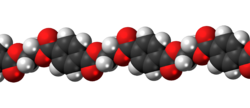Polyethylene terephthalate
 |
|
 |
|
 |
|
| Names | |
|---|---|
|
IUPAC name
Poly(ethyl benzene-1,4-dicarboxylate)
|
|
| Identifiers | |
|
25038-59-9 |
|
| Abbreviations | PET, PETE |
| ECHA InfoCard | 100.121.858 |
| Properties | |
| (C10H8O4)n | |
| Molar mass | variable |
| Density | 1.38 g/cm3 (20 °C),amorphous: 1.370 g/cm3,single crystal: 1.455 g/cm3 |
| Melting point | > 250 °C, 260 °C |
| Boiling point | > 350 °C (decomposes) |
| practically insoluble | |
| Thermal conductivity | 0.15 to 0.24 W m−1 K−1 |
|
Refractive index (nD)
|
1.57–1.58, 1.5750 |
| Thermochemistry | |
| 1.0 kJ/(kg·K) | |
| Related compounds | |
|
Related Monomers
|
Terephthalic acid Ethylene glycol |
|
Except where otherwise noted, data are given for materials in their standard state (at 25 °C [77 °F], 100 kPa).
|
|
|
|
|
| Infobox references | |
Polyethylene terephthalate (sometimes written poly(ethylene terephthalate)), commonly abbreviated PET, PETE, or the obsolete PETP or PET-P, is the most common thermoplastic polymer resin of the polyester family and is used in fibers for clothing, containers for liquids and foods, thermoforming for manufacturing, and in combination with glass fiber for engineering resins.
It may also be referred to by the brand name Dacron; in Britain, Terylene; or, in Russia and the former Soviet Union, Lavsan.
The majority of the world's PET production is for synthetic fibers (in excess of 60%), with bottle production accounting for about 30% of global demand. In the context of textile applications, PET is referred to by its common name, polyester, whereas the acronym PET is generally used in relation to packaging. Polyester makes up about 18% of world polymer production and is the fourth-most-produced polymer; polyethylene (PE), polypropylene (PP) and polyvinyl chloride (PVC) are first, second and third, respectively.
PET consists of polymerized units of the monomer ethylene terephthalate, with repeating (C10H8O4) units. PET is commonly recycled, and has the number "1" as its recycling symbol.
Depending on its processing and thermal history, polyethylene terephthalate may exist both as an amorphous (transparent) and as a semi-crystalline polymer. The semicrystalline material might appear transparent (particle size < 500 nm) or opaque and white (particle size up to a few micrometers) depending on its crystal structure and particle size.
...
Wikipedia
